Birdfinding.info ⇒ Locally common in several parts of its natural range along the eastern flanks of the Andes. In Peru, the distinctive chlorogenys population can be found at several sites in the central Marañon Valley, and typical mitratus is common in Cuzco, including Machu Picchu, Ollantaytambo, and Limatambo. In Bolivia, it is especially common in Cochabamba. In Argentina, consistent areas include Calilegua National Park, Yala Provincial Park (Jujuy), the Salta area, and the hills above San Miguel de Tucumán. Established sites for urban populations include: in the Bay Area, Las Palmas Park, Sunnyvale; in Los Angeles, South Pasadena, Entradero Park, Belmont Heights, and downtown Orange; in southern Florida, downtown Fort Lauderdale, Miami Springs, and throughout Kendall; in Buenos Aires, Parque Pereyra; and in Barcelona, Parc Güell and Parc de la Ciutadella.
Mitred Parakeet
Psittacara mitratus
Andes of Peru, Bolivia, and Argentina; introduced elsewhere.

Approximate natural range of the Mitred Parakeet. © BirdLife International 2018
Native to eastern slopes of the Andes from northern Peru south to northwestern Argentina, where it occurs in humid forests, edges, and partly wooded habitats at elevations that span approximately 1,000 to 3,500m.
Range is somewhat discontinuous, with significant population centers in four disjunct areas: (1) the distinctive, isolated subspecies chlorogenys in northern Peru (southern Amazonas and northern San Martín); (2) central Peru from Huanuco to Cuzco; (3) central Bolivia from La Paz to Santa Cruz; (4) southernmost Bolivia to Catamarca, Argentina.
Introduced urban populations are established in: the Bay Area and Los Angeles, California; southeastern Florida; Buenos Aires and La Plata, Argentina; and Barcelona, Spain. Smaller populations are more tenuously established around Lima and Arequipa, Peru.
In Hawaii, an introduced population on eastern Maui grew to over 200 during the 1990s, but it became the focus of a control program, and only a few remained into the 2010s. Starting in the late 1990s, small flocks have occasionally been observed on the Big Island along the Kona Coast.
Identification
Confusingly variable and similar to several related species. A large, green parakeet with a large ivory or off-white bill, a broad whitish eyering of bare skin, a red forehead, and variable amounts of red on the face that usually extend below and behind the eye and in irregular patches elsewhere on the head. It usually has smaller flecks of red scattered elsewhere on the neck and underparts, and sometimes on the back and wings.
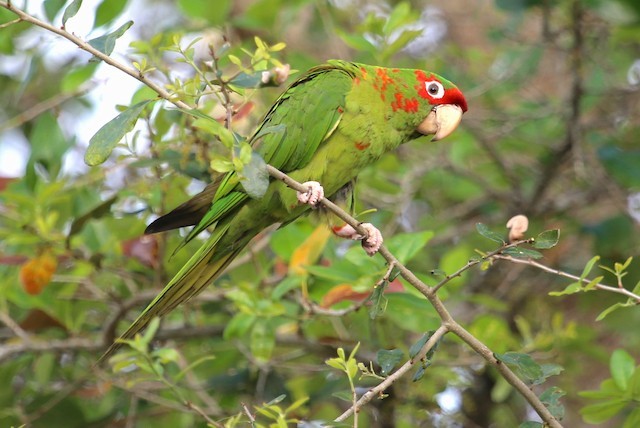
Mitred Parakeet. (Kendall, Florida; March 23, 2014.) © Tammy McQuade
Much of the variation follows a geographical pattern in which northern populations (especially the northernmost, chlorogenys of northern Peru) have mostly green heads with red mostly on the forehead, and southern populations (especially the southernmost, tucumanus of northwestern Argentina) have more extensive red. In the latter populations some individuals have mostly red heads.
All populations tend to have irregular, blotchy patches and scattered flecks of red that can appear almost anywhere on the body.
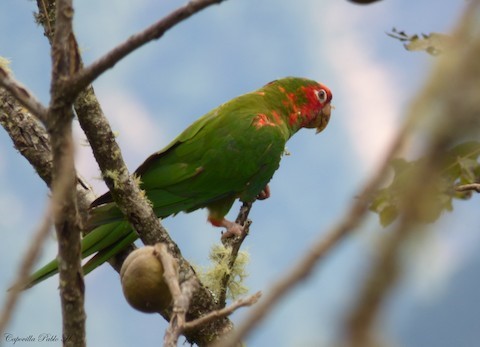
Mitred Parakeet, P. m. tucumanus. (Valle Grande, Jujuy, Argentina; April 19, 2019.) © Pablo Hernan Capovilla

Mitred Parakeet, P. m. mitratus. (Humahuaca Pass, Tumbaya, Jujuy, Argentina; October 14, 2014.) © Kurt Hennige
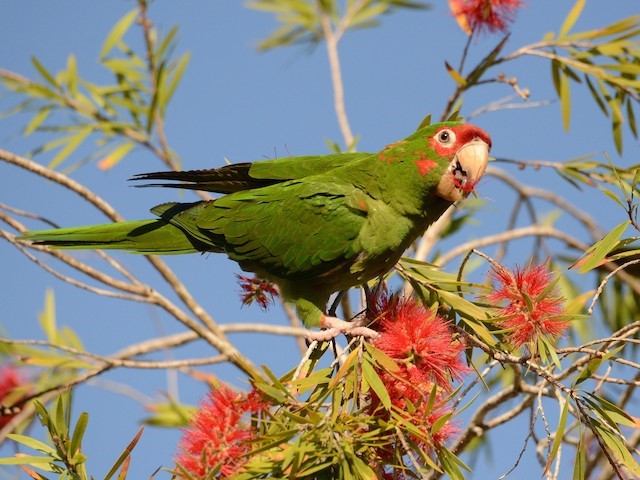
Mitred Parakeet. (Kings Creek Village, Glenvar Heights, Florida; April 6, 2018.) © Alan Van Norman

Mitred Parakeet, P. f. mitratus. (Inkaterra Hacienda, Urubamba, Cuzco, Peru; August 17, 2018.) © Theresa Bucher

Mitred Parakeet, P. m. mitratus. (Cuesta de Singuil, Ambato, Catamarca, Argentina; February 5, 2018.) © Silvia Vitale

Mitred Parakeet. (Kings Creek Village, Glenvar Heights, Florida; May 18, 2018.) © Steve Calver
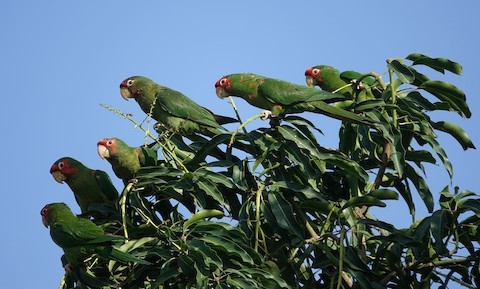
Mitred Parakeet, P. m. mitratus, flock showing variable amounts of red blotches and flecks. (Red-fronted Macaw Reserve, Cochabamba, Bolivia; September 22, 2019.) © Paul Bartlett
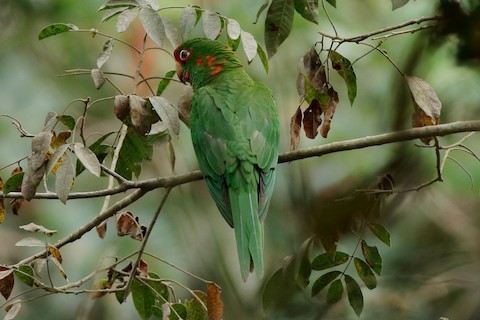
Mitred Parakeet, P. f. mitratus. (Yolosa-Yolosita Highway, La Paz, Bolivia; June 27, 2016.) © Manfred Bienert
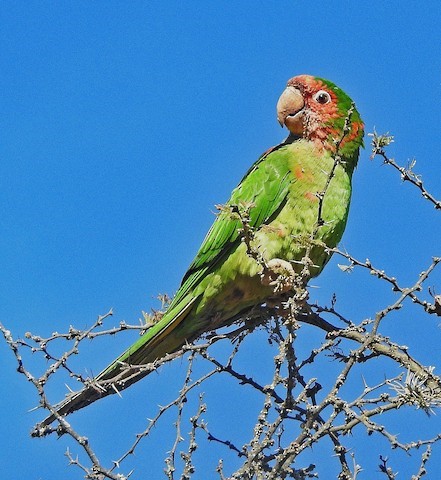
Mitred Parakeet, P. m. tucumanus, showing pink instead of red patches. (Las Juntas, Ambato, Catamarca, Argentina; September 11, 2016.) © Hugo Hulsberg
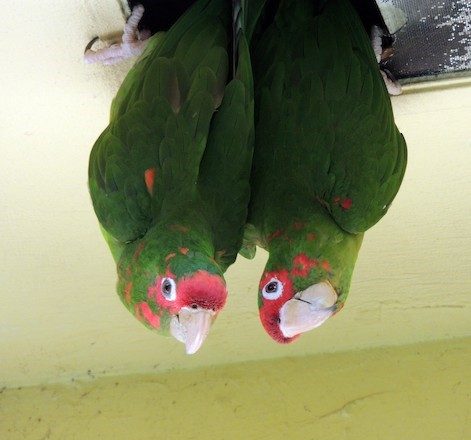
Mitred Parakeet. (Baptist Hospital, Kendall, Florida; April 18, 2013.) © Jeff Chapman

Mitred Parakeet. (Kings Creek Village, Glenvar Heights, Florida; May 18, 2018.) © Steve Calver

Mitred Parakeet, P. m. mitrata. (Red-fronted Macaw Reserve, Cochabamba, Bolivia; September 22, 2019.) © Paul Bartlett
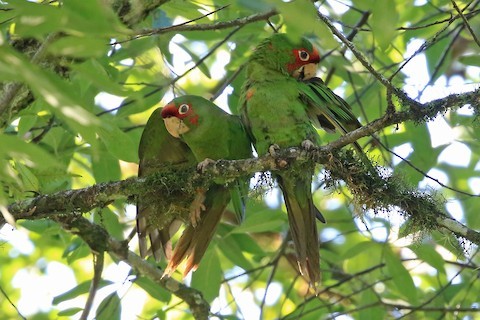
Mitred Parakeet, P. m. tucumanus. (Quebrada Los Sosa, Monteros, Tucumán, Argentina; January 13, 2017.) © Phillip Edwards

Mitred Parakeet. (Baptist Hospital, Kendall, Florida; October 15, 2017.) © Camille Merrell

Mitred Parakeet, P. m. mitratus. (Red-fronted Macaw Reserve, Cochabamba, Bolivia; September 22, 2019.) © Paul Bartlett
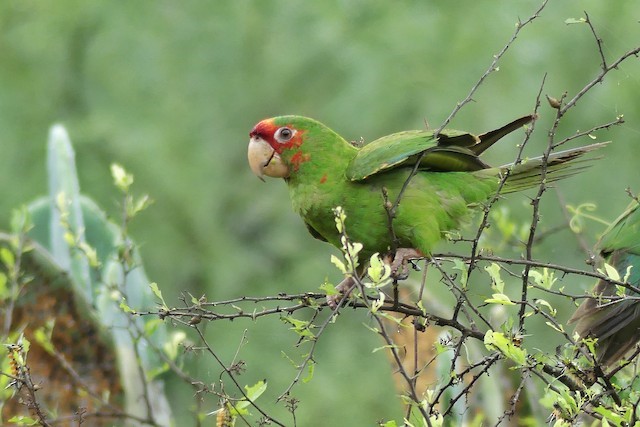
Mitred Parakeet, P. m. tucumanus. (El Ceibalito, Cerrillos, Salta, Argentina; January 5, 2019.) © Jorge Quiroga
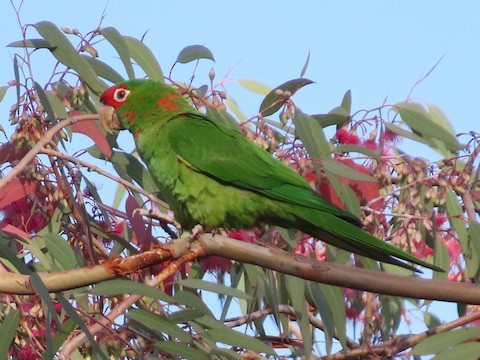
Mitred Parakeet. (Las Palmas Park, Sunnyvale, California; May 2, 2019.) © Barry Langdon-Lassagne
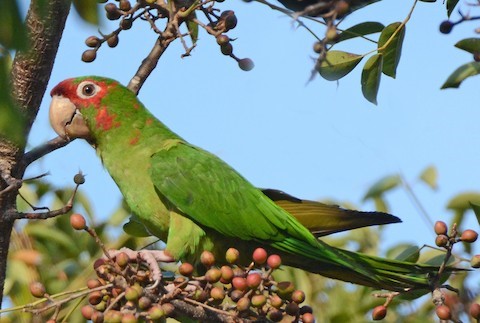
Mitred Parakeet. (Baptist Hospital, Kendall, Florida; March 21, 2015.) © Steven Mlodinow
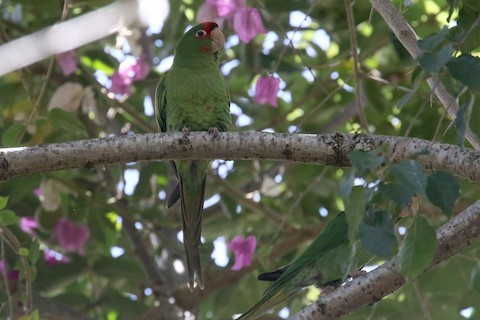
Mitred Parakeet, P. m. chlorogenys. (El Chillo Lodge, Amazonas, Peru; October 16, 2018.) © Noah Strycker

Mitred Parakeet, P. m. chlorogenys. (Casa Hacienda Achamaqui, Amazonas, Peru; March 9, 2018.) © Fernando Angulo – CORBIDI
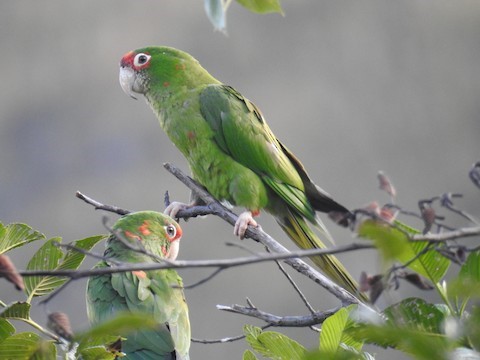
Mitred Parakeet, P. m. chlorogenys. (Casa Hacienda Achamaqui, Amazonas, Peru; March 9, 2018.) © Fernando Angulo – CORBIDI
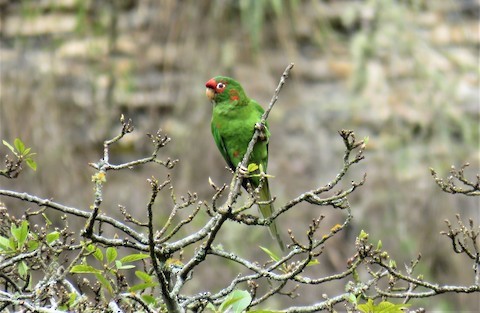
Mitred Parakeet, P. m. chlorogenys. (Nogal Cucho, Amazonas, Peru; September 21, 2019.) © Michel Turcot
Immatures can have little or no red on the face, or red limited to the forehead, and are potentially mistaken for several closely related species that may occur with it in areas where it is introduced.
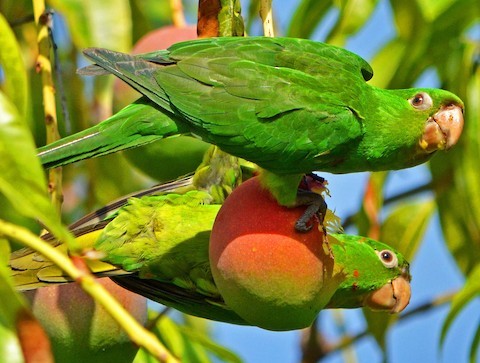
Mitred Parakeet, immatures. (Flamingo Park, Miami Beach, Florida; May 19, 2012.) © Carol Berney
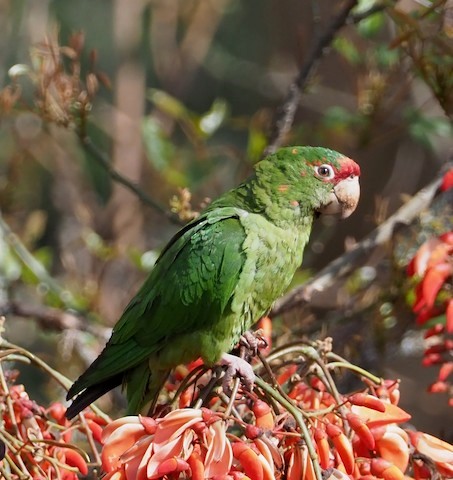
Mitred Parakeet, P. f. mitratus, immature. (Limatambo, Cuzco, Peru; October 24, 2019.) © John Anderson

Mitred Parakeet, P. f. mitratus, immature. (Machu Picchu, Cuzco, Peru; February 13, 2018.) © Fernando Angulo – CORBIDI
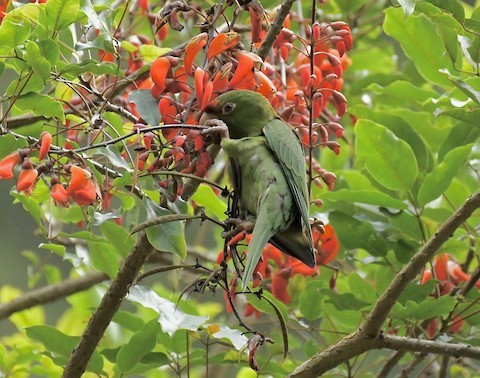
Mitred Parakeet, P. f. mitratus, immature. (Aguas Calientes, Cuzco, Peru; August 18, 2018.) © Theresa Bucher

Mitred Parakeet, P. f. mitratus, immature. (Aguas Calientes, Cuzco, Peru; August 18, 2018.) © Theresa Bucher

Mitred Parakeet, immature. (Pompano Beach, Florida; January 29, 2016.) © Jonathan Bontrager
The wings tend to be all-green—depending on the lighting, the underwing may appear brownish-olive or yellowish. Some individuals, especially in southern populations, have some red on the wings, usually on the leading edge.
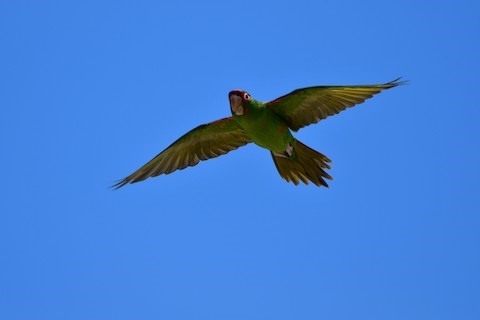
Mitred Parakeet. (Boynton Beach Inlet, Florida; August 24, 2018.) © Marcus Kelly

Mitred Parakeet, P. f. mitratus. (Cuzco, Peru; November 17, 2018.) © John Patten Moss
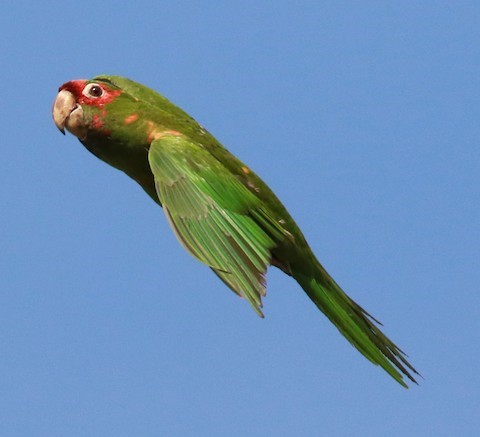
Mitred Parakeet. (Kendallwood, Florida; December 7, 2016.) © Jordan Roderick

Mitred Parakeet. (Kings Creek Village, Glenvar Heights, Florida; April 7, 2018.) © Carol Riddell

Mitred Parakeets showing green upperwings. (UCLA campus, Los Angeles, California; January 10, 2019.) © Tom Benson
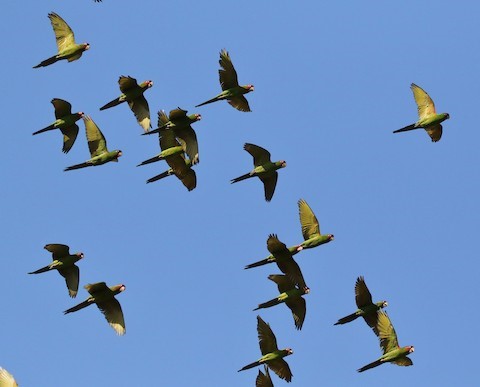
Mitred Parakeets showing yellowish underwings. (UCLA campus, Los Angeles, California; January 10, 2019.) © Tom Benson
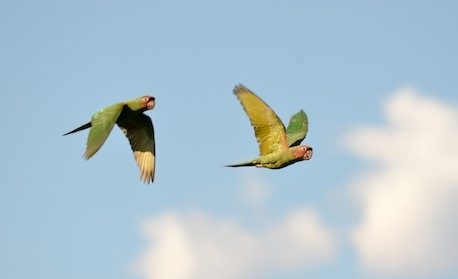
Mitred Parakeet, P. m. tucumanus, showing some red on the leading edge of the underwing. (Potrero de Yala, Jujuy, Argentina; February 2, 2020.) © Nikolaj Mølgaard Thomsen

Mitred Parakeet. (Las Palmas Park, Sunnyvale, California; June 26, 2018.) © Brooke Miller

Mitred Parakeet, P. f. mitratus, showing an atypical red leading edge on the underwing. (Santa Cruz, Bolivia; June 25, 2019.) © Jay McGowan

Mitred Parakeet. (UCLA campus, Los Angeles, California; January 11, 2019.) © James Bailey
Cf. Cordilleran Parakeet. In the Marañon Valley of northern Peru, two extremely similar populations of Psittacara parakeets occur together: chlorogenys (an atypical subspecies of Mitred) and minor (Cordilleran, which is often classified as a form of Scarlet-fronted). Both populations have approximately the same distribution of red on the head and neck—both have the typical Cordilleran pattern, which is not typical of other Mitred or Scarlet-fronted.
The only consistent difference between them is that minor (Cordilleran) typically shows red on the leading edge of the wing, most noticeable in flight from below, whereas chlorogenys (Mitred) has a uniformly green underwing—depending on the lighting, it can also appear brownish-olive or yellowish, but not red.
In context, knowing that both populations look like Cordilleran but differ in wing markings, their identification is straightforward. In this case the confusion is due mainly to inconsistent species-level classification of the populations, and the fact that these overlapping populations resemble one another more than they resemble distant populations that are often assigned to the same species.
Cf. Red-masked Parakeet. Their natural ranges are not known to overlap, but introduced populations of Mitred and Red-masked Parakeets occur together in several cities. Mitred has highly variable plumage, an inherently confusing species, whereas adult Red-masked has a consistent pattern. Immature plumages of the two species can be essentially identical, and are usually identifiable only by their association with adults.
Adult Red-masked is distinguished by its contiguous red hood, which tapers toward the chin. The red area sometimes has a rough border and a few stray specks, but usually gives a helmet-like impression. Mitred can show essentially the same amount of red on the head, but its distribution is blotchier, with scattered specks of red over a wider area. Red-masked shows red on the shoulder of the folded wing and a distinct red bar on the leading edge of the underwing, where Mitred shows little or no red.
Voice can be a useful clue. Mitred and Red-masked have similar repertoires, but Red-masked’s calls tend to be higher-pitched: its nasal creaking has a jay-like quality and its screams are thin and piercing. Mitred’s nasal creaking is mellower and its screams are harsher, less shrill than Red-masked’s.
Cf. Other Psittacara Parakeets. In areas where it is introduced, Mitred is easily confused with various other members of its genus, both immature and adult plumages.
Notes
Polytypic species consisting of four currently recognized subspecies: chlorogenys of northern Peru; alticola of upper elevations in southeastern Peru and possibly western Bolivia; mitrata of central Peru to northwestern Argentina; and tucumanus of northwestern Argentina.
Alticola has at times been recognized or proposed as a distinct form or species (either Chapman’s Parakeet or Mountain Conure), but there seems to be little evidence that it exists as a recognizable population. Another putative species, Hocking’s Parakeet (P. hockingi), is generally thought to represent an immature plumage of Mitred.
References
Alderfer, J., and J.L. Dunn. 2014. National Geographic Complete Birds of North America (Second Edition). National Geographic Society, Washington, D.C.
BirdLife International. 2018. Psittacara mitratus. The IUCN Red List of Threatened Species 2018: e.T22685669A132058859. https://dx.doi.org/10.2305/IUCN.UK.2018-2.RLTS.T22685669A132058859.en. (Accessed June 18, 2020.)
eBird. 2020. eBird: An online database of bird distribution and abundance. Cornell Lab of Ornithology, Ithaca, N.Y. http://www.ebird.org. (Accessed June 18, 2020.)
Forshaw, J.M. 2010. Parrots of the World. Princeton University Press.
Juniper, T., and M. Parr. 1998. Parrots: A Guide to Parrots of the World. Yale University Press.
Pyle, R.L., and P. Pyle. 2017. The Birds of the Hawaiian Islands: Occurrence, History, Distribution, and Status. Version 2 (January 1, 2017). http://hbs.bishopmuseum.org/birds/rlp-monograph/. B.P. Bishop Museum, Honolulu, Hawaii.
Schulenberg, T.S., D.F. Stotz, D.F. Lane, J.P. O’Neill, and T.A. Parker. 2007. Birds of Peru. Princeton University Press.
Xeno-Canto. 2020. Mitred Parakeet – Psittacara mitratus. https://www.xeno-canto.org/species/Psittacara-mitratus. (Accessed June 19, 2020.)
